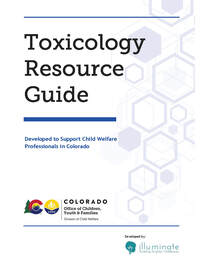Glossary of Terms |
Assay: a method of lab testing Ataxia: unbalanced
Biologic Matrices: bodily fluids that can be tested - urine, blood, hair, saliva, meconium, umbilical cord
Bradycardia: low heart rate Bradypnea: slow breathing
Chronicity: chronic and/or habitual use Diaphoresis: sweaty
False negative: undetected substance, despite exposure. This may occur of the concentrations are below the limits of detection, beyond the time of detection, or the assay does not detect the substance despite being in the drug category.
False positive: detected substance, despite no exposure. This may occur if a drug has a similar structure to the drug category, such as dextromethorphan and PCP.
Hypertension: high blood pressure Hypoglycemia: low blood sugar
Hypoplastic philtrum: underdevelopment of the upper lip Hypotension: low blood pressure
Immunoassay: a biochemical test measuring the presence of a substances, typically using an antibody or antigen
Maxillary hypoplasia: underdevelopment of the cheek bones
Meconium: A newborn's first stool, or poop, which is sticky, thick, and dark green and is composed of materials ingested during pregnancy beginning around week 12
Metabolite: compounds that have resulted from metabolism of the original drug
Microcephaly: small head Micrognathia: small jaw Miosis: small pupils Mydriasis: large pupils
Nystagmus: shaking eyesPalpebral fissures: opening between the eyelids Parent Compound: original drug
Perinatal: around time of birth Prenatal: before birth Postpartum: after delivery
Qualitative: results will be positive or negative. A positive test must meet a minimum concentration. Thus, will not tell you if the results have extremely high levels. On the contrary, low level exposures that are below the limit of detection will return negative
Quantitative: results will be in a concentration: ie mg/dl, etc.
Sensitivity: The ability of a drug test to correctly identify those with a drug exposure Specificity: The ability of a drug test to correctly identify those without a drug exposure
Systemic Exposure: a drug that actually gets absorbed (any route) and can become detectable.
Tachycardia: fast heart rate Tachypnea: fast breathing
Toxidrome: constellation of signs and symptoms consistent with a specific or category of substances.
Biologic Matrices: bodily fluids that can be tested - urine, blood, hair, saliva, meconium, umbilical cord
Bradycardia: low heart rate Bradypnea: slow breathing
Chronicity: chronic and/or habitual use Diaphoresis: sweaty
False negative: undetected substance, despite exposure. This may occur of the concentrations are below the limits of detection, beyond the time of detection, or the assay does not detect the substance despite being in the drug category.
False positive: detected substance, despite no exposure. This may occur if a drug has a similar structure to the drug category, such as dextromethorphan and PCP.
Hypertension: high blood pressure Hypoglycemia: low blood sugar
Hypoplastic philtrum: underdevelopment of the upper lip Hypotension: low blood pressure
Immunoassay: a biochemical test measuring the presence of a substances, typically using an antibody or antigen
Maxillary hypoplasia: underdevelopment of the cheek bones
Meconium: A newborn's first stool, or poop, which is sticky, thick, and dark green and is composed of materials ingested during pregnancy beginning around week 12
Metabolite: compounds that have resulted from metabolism of the original drug
Microcephaly: small head Micrognathia: small jaw Miosis: small pupils Mydriasis: large pupils
Nystagmus: shaking eyesPalpebral fissures: opening between the eyelids Parent Compound: original drug
Perinatal: around time of birth Prenatal: before birth Postpartum: after delivery
Qualitative: results will be positive or negative. A positive test must meet a minimum concentration. Thus, will not tell you if the results have extremely high levels. On the contrary, low level exposures that are below the limit of detection will return negative
Quantitative: results will be in a concentration: ie mg/dl, etc.
Sensitivity: The ability of a drug test to correctly identify those with a drug exposure Specificity: The ability of a drug test to correctly identify those without a drug exposure
Systemic Exposure: a drug that actually gets absorbed (any route) and can become detectable.
Tachycardia: fast heart rate Tachypnea: fast breathing
Toxidrome: constellation of signs and symptoms consistent with a specific or category of substances.

